Understanding the Cost Factors of Obsidian


Intro
In the realm of gemstones, obsidian possesses a unique allure. This volcanic glass, formed from rapidly cooled lava, has captivated humans for millennia. Understanding the factors affecting its cost requires a thorough examination of its origins, properties, market dynamics, and technological implications. Through this exploration, enthusiasts can gain clarity on why certain types of obsidian command higher prices and how its value is assessed within the broader gemstone market.
Gemstone Overview
Definition and Origins
Obsidian is a naturally occurring volcanic glass known for its smooth texture and striking appearance. It is predominantly created when lava cools swiftly, not allowing enough time for crystals to form. This results in a glassy, shiny surface that varies in color, including shades of black, green, and brown. Its formation process can happen in various volcanic regions around the world, which contributes to the diversity of its types and qualities.
Historical Significance
Historically, obsidian has been more than a gemstone; it has served as a crucial material for tools, weapons, and ornaments. Its sharp edges made it valuable to early human communities for cutting and hunting. Cultures, such as the Aztecs, revered obsidian not only for its practicality but also for its spiritual significance. Today, its cultural legacy impacts its modern valuation and desirability, providing context for its pricing.
Gemstone Properties
Hardness and Durability
Obsidian ranks about 5 to 5.5 on the Mohs scale, indicating moderate hardness. While it is relatively durable regarding daily wear in jewelry, it is more prone to chipping compared to harder gemstones like diamonds or sapphires. Buyers need to be aware of proper care and storage to maintain the integrity of obsidian items, especially jewelry.
Color and Clarity
The visual appeal of obsidian largely stems from its color and clarity.
- Common colors: black, dark green, mahogany, and rainbow.
- Clarity: Typically, obsidian is clear, allowing light to pass through in some cases, enhancing its beauty.
Color variations can significantly affect the gemstone's price. For example, the rare rainbow obsidian or the striking snowflake obsidian can fetch higher prices due to their unique appearances.
“The intrinsic properties of obsidian influence not only its aesthetic value but also its market demand.”
As we delve deeper into the analysis of obsidian costs, it will be essential to explore how these factors, along with sourcing and market dynamics, intertwine to shape the financial landscape of this fascinating gemstone.
Prolusion to Obsidian
Obsidian is not only a captivating natural substance, it plays a significant role in various fields. Understanding this unique volcanic glass can benefit gemstone enthusiasts, collectors, jewelry designers, and even geology enthusiasts. In this section, we will explore obsidian’s definition and its historical relevance, laying a solid foundation for discussing its cost and other intricacies later.
Definition and Formation
Obsidian is a naturally occurring volcanic glass formed when lava cools rapidly. This process prevents the structuring of crystals, resulting in a solid glass. The primary chemical composition of obsidian consists mainly of silicon dioxide, with varying amounts of other oxides like aluminum, iron, and magnesium, depending on the source. Its texture is often smooth and glassy, varying in colors such as black, brown, green, and even red. This diversity in appearance makes it attractive for different applications, ranging from decorative items to tools in ancient times.
Historical Significance
Obsidian has a rich history that stretches back thousands of years. It was used by ancient civilizations across the globe. For instance, the Aztecs and Maya valued it highly for crafting tools, weapons, and ceremonial items. Its sharpness made it ideal for cutting instruments. Moreover, obsidian trading routes were established due to its demand, highlighting its economic value in those cultures. In addition, obsidian's cultural significance remains strong in contemporary settings, often being recognized for its archeological value and aesthetic allure.
Understanding obsidian’s definition and its historical layers provides insight into the factors affecting its price. The narrative surrounding obsidian extends beyond mere aesthetics to encompass its geological characteristics and cultural importance, establishing a comprehensive grounding for its cost analysis.
Types of Obsidian
The variety in obsidian types is one of the most significant aspects influencing its cost. Differentiation between these types often stems from their appearance, rarity, and the unique qualities each possesses. Understanding these distinctions is essential not only for consumers but also for collectors and jewelry designers. Each type has specific characteristics that cater to individual tastes and preferences, thus creating a diverse market.
Black Obsidian
Black obsidian is the most commonly recognized form of obsidian. Its deep black color arises from high iron and magnesium content, making it a favorite in both jewelry and decor. The shiny surface is a key feature, lending well to various settings. In terms of cost, black obsidian is generally more affordable than other types due to its abundance. It is widely available in the market and is often used for jewelry making, leaving it in high demand.
This type holds cultural significance in many societies. It has been utilized by ancient civilizations for tools and weapons, showcasing its historical importance.
Snowflake Obsidian
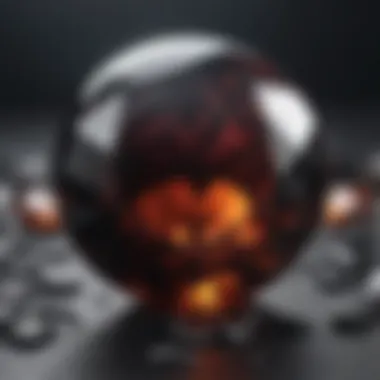
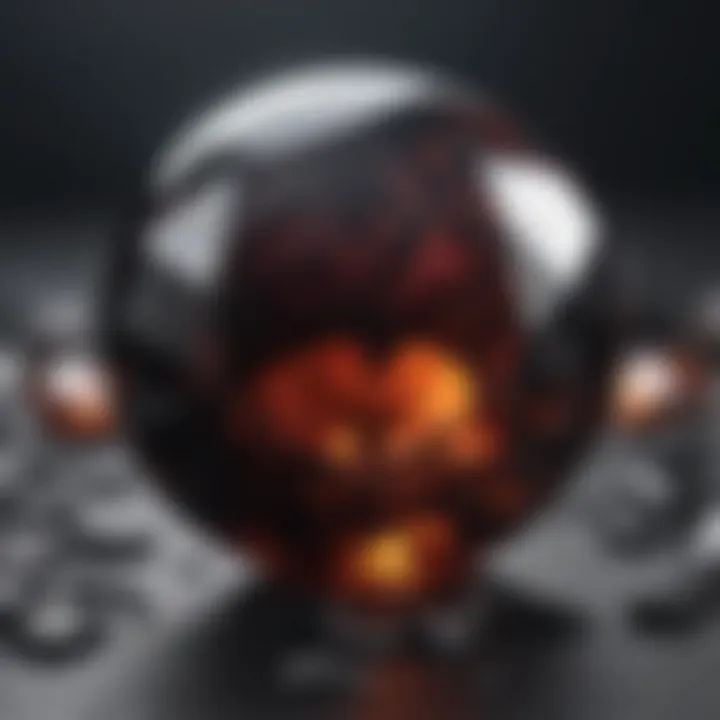
Snowflake obsidian is unique due to its striking white patterns that look like snowflakes against the black background. These patterns are formed by the inclusion of cristobalite, a crystalline form of silica. This type can be somewhat pricier than black obsidian due to its aesthetic appeal and limited availability. The distinct appearance makes it popular among collectors and jewelry creators.
Snowflake obsidian is often associated with grounding qualities and is believed to aid in emotional balance. Consumers may be willing to pay more for its supposed metaphysical properties. This adds another layer to its value in the market.
Red Obsidian
Red obsidian is less common and exhibits a beautiful reddish hue that is captivating. Its coloration is due to the presence of iron oxides. The rarity of red obsidian often results in higher prices when compared to black and snowflake versions. It features a smooth, reflective exterior which enhances its appeal.
This type is popular among gemstone enthusiasts and collectors, partly due to its vibrant color and the less frequent occurrence in natural deposits. Its distinctiveness makes it a desirable choice for jewelers, which further drives its market value.
Rainbow Obsidian
Rainbow obsidian is renowned for its beautiful, iridescent play of colors that can be seen when light shines upon its surface. This variety is relatively rare and the visual qualities significantly influence its price. Collectors are often drawn to its unique beauty, making it a sought-after item. The various hues can include blues, greens, and purples, adding to its complexity.
The rarity and vibrant aesthetic make rainbow obsidian one of the more expensive options in the obsidian category. For those seeking to create stunning jewelry pieces, its allure does not go unnoticed.
In summary, each type of obsidian presents its own distinct qualities that contribute to its overall value. Understanding these types not only enriches knowledge for buyers but also assists in navigating the gemstone market effectively.
"The appeal of obsidian goes beyond mere aesthetics; it carries historical weight, cultural significance, and metaphysical properties that can influence its market pricing."
As consumers become more discerning in their choices, a clear understanding of different obsidian types proves to be an asset.
Factors Affecting Obsidian Cost
Understanding the factors affecting obsidian cost is crucial for anyone interested in this unique mineral. The price of obsidian does not solely depend on its aesthetic appeal but is influenced by multiple elements that contribute to its value. By examining geological characteristics, sourcing locations, market demand, and cultural significance, one can gain better insight into how these factors interplay to impact pricing. This section will explore each element carefully to provide a comprehensive view.
Geological Characteristics
The geological characteristics of obsidian are among the primary factors influencing its cost. This volcanic glass is formed when lava cools rapidly, resulting in its smooth texture and rich colors. The unique conditions of formation, including temperature and the chemical composition of the lava, can vary significantly.
- Color: Varieties of obsidian display different colors including black, red, and green. The rarity of specific colors boosts their price significantly.
- Presence of inclusions: Some obsidians may contain minerals or bubbles trapped inside, which can affect their market value.
- Quality: High-quality obsidian with minimal flaws or imperfections will naturally command a higher price. Assertive clarity in color and texture also enhances perceived value.
Understanding these geological factors enables buyers to distinguish between lower and higher quality varieties, therefore making informed purchasing decisions.
Sourcing Locations
The place where obsidian is sourced has a considerable influence on its cost. Certain areas produce obsidian that is known for its unique properties, making them more desirable.
- Geographic Origins: Obsidian from regions like Mexico, Turkey, and the United States (particularly the Western states) can be more sought after due to their distinct features.
- Accessibility: Locations that are more accessible will have lower sourcing costs, while remote areas can increase these due to transportation challenges.
- Sustainability: Modern consumers often prefer ethically sourced materials. Locations that focus on sustainable mining practices can attract buyers willing to pay a premium for responsibly sourced obsidian.
These elements combined demonstrate how sourcing can directly influence the final price tag of obsidian.
Market Demand
Market demand plays a pivotal role in the pricing of obsidian. Enthusiasm for gemstone collecting has been steadily increasing, leading to greater competition for quality specimens.
- Trends: Fashion and popular trends can lead to spikes in demand. When particular styles are on the rise, obsidian jewelry and artifacts become more sought after.
- Collector Interest: Collectors drive demand based on the rarity and unique qualities of certain pieces. High-quality obsidian artifacts often become valuable in the collectors' market.
- Societal Influence: Cultural shifts towards spirituality and wellness can enhance the desirability of natural stones like obsidian, further pushing up prices.
This ebb and flow of demand must be closely monitored as it can affect pricing substantially on a year-to-year basis.
Cultural Significance
The cultural significance of obsidian adds another layer to its cost dynamics. Historically, obsidian has been used in various artifacts, tools, and objects across cultures.
- Historical Usage: In ancient civilizations, obsidian was valued for tools and weapons. Its historical significance fuels collector interest, driving prices higher.
- Symbolism: For many cultures, obsidian holds spiritual or protective qualities. This belief increases its demand among those interested in metaphysical properties, often resulting in higher prices.
- Artistic Value: Many artisans create sculptures, beads, and other items from obsidian, which are highly valued within artistic communities.
In summary, the cultural narrative surrounding obsidian impacts its perceived value and, consequently, its cost in the market.
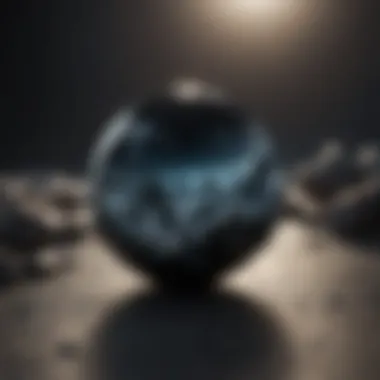

Pricing Structures in the Market
Understanding the pricing structures of obsidian is crucial for anyone involved in the gemstone market. These pricing models reflect various factors that determine the final cost of obsidian, including quality, source, and market demand. With knowledge of the different pricing tiers, buyers can make informed decisions whether they are acquiring obsidian for personal use, resale, or as part of a collection.
Retail Pricing
Retail pricing for obsidian often varies significantly based on several factors. First, the quality of the obsidian plays a major role. High-grade obsidian can fetch a higher price than common varieties due to its clarity, color, and texture. Retailers may also consider the cost incurred through the extraction and processing of the stone. Other important elements include presentation and packaging, especially for gemstones marketed as jewelry. The market price can also fluctuate based on current trends, specialty applications, and consumer preferences.
In most cases, focusing on reputable sellers will yield better insights into retail pricing. Understanding how these sellers determine their prices can empower buyers. Here are some key aspects that influence retail pricing:
- Quality Assessment: Authenticity and purity are evaluated.
- Branding: A well-known brand can charge higher prices.
- Trends: Seasonal market trends may impact buyer interest.
- Location: Pricing can differ based on geographic demand.
The importance of obtaining detailed product information cannot be overstated; it ensures that you, as a consumer, receive fair value for your investment.
Wholesale Pricing
Wholesale pricing structures differ from retail pricing mainly in volume and distribution. Wholesalers purchase larger quantities directly from suppliers or mines, enabling them to offer reduced rates to retailers and smaller buyers. This pricing tier often reflects a significant bulk discount, allowing for a lower price per unit.
Factors that influence wholesale pricing include:
- Bulk Orders: Larger quantities yield better pricing.
- Supplier Relationships: Long-standing relationships with suppliers may lead to favorable pricing agreements.
- Shipping Costs: Transportation expenses for large orders can affect prices.
- Market Stability: Fluctuations in demand can alter wholesale price strategies.
To understand the true value of wholesale pricing, one must consider the above elements and examine market reports and trends regularly, which can result in favorable purchasing opportunities.
Collector Pricing
Collector pricing for obsidian often factors in rarity, historical significance, and collecting trends. A unique piece, such as a rare color or form, can command significantly higher prices among collectors. Collectors also consider the provenance of pieces, which adds to their value.
Key considerations for collector pricing include:
- Rarity: Unique pieces hold greater value.
- Provenance: Documented history influences desirability.
- Market Trends: Shifts in collector demand can affect prices.
- Condition: Well-preserved pieces are more valuable.
Comparative Analysis with Other Gemstones
Importance of Comparative Analysis in Context
The comparative analysis of obsidian with other gemstones provides vital insights into its unique position in the gemstone market. It allows enthusiasts and collectors to understand how obsidian stacks up against more traditional gemstones like diamonds or sapphires. This understanding helps in grasping not only the aesthetics and cultural significance of obsidian but also the pricing dynamics that emerge when it is juxtaposed with other materials. By evaluating such comparisons, we can draw informed conclusions about the value, desirability, and potential future trends of obsidian.
Moreover, analyzing obsidian alongside common materials like glass and onyx reveals how geological origins, physical properties, and market perception play critical roles in their pricing. These comparisons assist buyers in making informed decisions based on performance characteristics, durability, and aesthetic appeal.
Obsidian vs. Glass
Obsidian and glass share a superficial similarity in appearance. Both are shiny, black, and can exhibit sharp edges. However, the distinct differences in origin and properties create a considerable gap in their value and market perception.
Origin and Composition: Obsidian is a naturally occurring volcanic glass formed from rapidly cooled lava. In contrast, glass is manufactured from silica and other materials in a controlled environment. This natural formation gives obsidian unique characteristics, such as varied inclusions and formations that can enhance its appeal to collectors and gem enthusiasts.
Physical Characteristics: Obsidian is known for its exceptional hardness, scoring about 5.5 on the Mohs scale. Glass, depending on its type, can be much softer, making it less durable over time. For jewelry makers and designers, the durability of obsidian can be an essential selling point.
Market Value: As a result of its rarity and natural origin, obsidian generally commands higher prices in the market compared to glass. While decorative glass items can be produced cheaply, genuine obsidian, especially variations like snowflake obsidian or rainbow obsidian, can fetch a premium in both retail and collector markets.
"Understanding the intrinsic differences between obsidian and glass is key for both buyers and sellers in the gemstone market."
Obsidian vs. Onyx
Obsidian and onyx are often conflated, yet they represent different materials with unique properties. Obsidian is an igneous rock, while onyx is a banded form of chalcedony, a type of quartz.
Formation: Obsidian originates from volcanic activity, while onyx is formed within sedimentary environments. This fundamental difference plays a crucial role in their appearance and value. Whereas obsidian displays a solid, glossy finish, onyx often features layered patterns of contrasting colors.
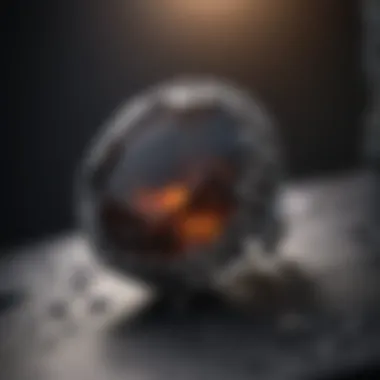
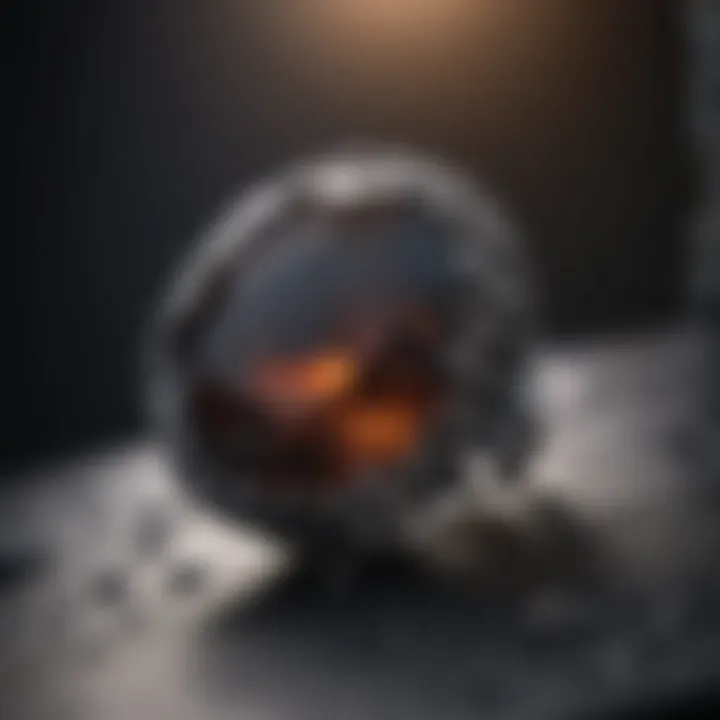
Aesthetics and Variability: In terms of aesthetic appeal, obsidian typically provides a dramatic, siren black look, whereas onyx presents a more subdued and classical design. This can impact their use in various jewelry applications. Specifically, onyx is favored for more traditional or formal pieces, while obsidian is often marketed towards modern, avant-garde designs.
Price Comparison: The price points for both materials can vary significantly based on quality, rarity, and market trends. While both have their own niches, high-quality obsidian can sometimes command even higher prices than onyx.
To sum up, comparing obsidian against glass and onyx helps to uncover the complexities of its market positioning and pricing trends. An informed consumer will appreciate these nuances as they contemplate their purchase decisions.
The Role of Technology in Obsidian Pricing
Technology plays a significant role in determining the cost of obsidian. The advancements in techniques and tools used for crafting and selling obsidian have a direct impact on its market price. In this section, we will explore how methods such as cutting and polishing, as well as the influence of online marketplaces, shape the pricing landscape for this unique volcanic glass.
Cutting and Polishing Techniques
The cutting and polishing techniques utilized on obsidian greatly affect its final price. Different approaches yield varying levels of quality and appearance.
- Precision Cutting: Using advanced machinery, craftsmen can achieve more intricate designs.
- Polishing Standards: High-quality polishing techniques enhance the glass-like shine of obsidian, making it more appealing to buyers.
- Shape and Size: Obsidian can be fashioned into various shapes, from raw chunks to carefully crafted gemstones. The precise cuts not only improve aesthetics but also ensure the material's structural integrity.
These methods require skilled artisans and sophisticated equipment, which can lead to increased production costs. Higher production costs typically transfer to the consumer, influencing the retail price of finished obsidian products.
Online Marketplaces Impact
Online marketplaces have transformed the way obsidian is bought and sold. Their impact on pricing is significant for several reasons:
- Increased Visibility: Sellers can reach a wider audience, allowing them to command higher prices for rare types of obsidian.
- Competition: More sellers in the market can lead to competitive pricing. This can benefit consumers who find better deals, but it can also pressure artisans to lower their prices.
- Customer Reviews and Transparency: Online platforms allow buyers to leave feedback and rate products. This transparency can positively or negatively affect a seller’s reputation, influencing demand and, consequently, pricing.
"Technology not only aids in the crafting process but also revolutionizes how gemstones are marketed and sold globally."
The synergy between craftsmanship and technology ensures that the obsidian market remains dynamic. Understanding these aspects gives consumers valuable insight into what affects the cost of this intriguing material.
Future Trends in Obsidian Market Pricing
Understanding the future trends in obsidian market pricing is crucial for various stakeholders, including collectors, investors, and jewelry designers. As a unique volcanic glass, obsidian’s appeal and market dynamics can shift based on numerous factors, including emerging technologies, changes in consumer preferences, and environmental considerations. Industry participants need to be aware of these trends to make informed decisions regarding sourcing, investment, and production strategies.
Forecasting Demand
The demand for obsidian is influenced by its various uses in jewelry, art, and as a healing stone. Current market analyses suggest that there is a growing interest in natural gemstones due to an increase in consumer awareness about synthetic alternatives. Additionally, the trend towards sustainable and ethically sourced materials further plays a significant role in obsidian's appeal.
- Emerging Markets: Countries with rich geological resources may start to recognize obsidian's value, leading to increased local demand. The rising middle class in nations like India and Brazil could boost interest in gemstones, including obsidian.
- Technological Integration: As online marketplaces enhance their platforms, obsidian can circulate faster among global consumers. Digital galleries and augmented reality tools allow buyers to view pieces without being in person, increasing accessibility.
- Cultural Trends: With the resurgence of interest in holistic healing practices and protective stones, obsidian's historical significance as a spiritual tool may attract a new generation of buyers. This could foster more demand for raw and uncut pieces as collectors seek unique items with history.
Forecasting demand accurately requires ongoing market research and analysis of consumer behaviors, including preferences for sustainable products.
Potential New Sources
As the market for obsidian develops, exploring new sourcing avenues becomes essential. With traditional sources possibly facing exhaustion or environmental limitations, suppliers and collectors should consider alternative locations and methods of obtaining obsidian.
- Geological Surveys: More detailed geological studies in under-explored regions may reveal new obsidian deposits. For instance, volcanic regions in countries like Indonesia and Italy could provide fresh sources.
- Environmental Practices: Sustainable mining techniques are becoming more crucial. Innovations like selective mining can help limit the ecological impact while still extracting valuable materials. This can create a niche market for ethically sourced obsidian.
- Recycling of Obsidian: There is also a shift towards recycling gemstones. Leftover materials from gemstone cutting, even if they are not traditionally valued, can be repurposed into art or healing items, thereby diversifying supply.
"The adaptability of obsidian sourcing methods could transform its market, ensuring sustainability alongside profitability."
The End
The conclusion of this article serves to encapsulate the myriad elements explored within the nuanced realm of obsidian pricing. It emphasizes that understanding these factors is crucial for anyone engaging with this unique volcanic glass, whether they are buyers, collectors, or industry professionals. The deliberation of the varied types of obsidian, alongside the geological and cultural contexts, provides invaluable insights into why some specimens command higher prices than others.
Summary of Key Points
- Types of Obsidian: We analyzed various types of obsidian, including black, snowflake, and rainbow varieties, each with unique attributes influencing their market value.
- Factors Influencing Cost: Geological characteristics such as source location and mineralization significantly impact the cost, as do broader market demand and cultural significance.
- Pricing Structures: Different pricing structures were identified, showing how retail, wholesale, and collector markets cater to varying buyer expectations and understanding.
- Comparative Analysis: The exploration into how obsidian holds its value against alternatives like glass and onyx gives a clearer perspective on its financial worth.
- Technological Influences: Advancements in cutting techniques and the rise of online marketplaces are reshaping how obsidian is bought and sold, demonstrating the dynamic nature of its pricing.
- Future Trends: Insights into forecasting demand and identifying potential new sources suggest that the market for obsidian will continue to evolve.
Implications for Buyers
For buyers, being informed about the complexities of obsidian pricing offers strategic advantages. Knowing that the geological origin affects value can guide decisions on what to purchase based on personal or investment goals. Buyers should also consider the cultural significance of specific types when selecting obsidian for jewelry or collections, as unique attributes often reflect personal taste and appreciation.
In addition, the varying structures of pricing mean buyers can navigate the market more effectively. Awareness of the distinctions between retail and wholesale pricing can lead to more favorable purchasing experiences.
Overall, the insights gleaned from this comprehensive analysis empower buyers to make informed choices within the obsidian market, ensuring they appreciate both the beauty and the investment potential of their acquisitions.
Understanding obsidian's value is not just a financial exercise; it's an exploration of the material's rich history and multifaceted uses, enhancing its allure.



